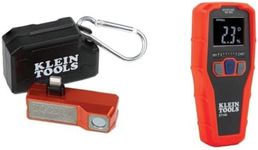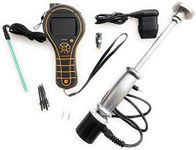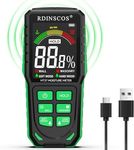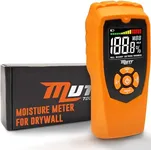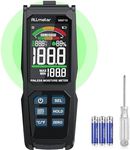Buying Guide for the Best Moisture Meter For Walls
Choosing the right moisture meter for walls is crucial for ensuring the structural integrity and safety of your home or building. Moisture meters help detect the presence of moisture in walls, which can prevent mold growth, wood rot, and other moisture-related issues. When selecting a moisture meter, it's important to consider several key specifications to ensure you get the best fit for your needs.Type of Moisture MeterThere are two main types of moisture meters: pin-type and pinless. Pin-type meters use two pins that are inserted into the material to measure moisture content, making them highly accurate but potentially damaging to the surface. Pinless meters use sensors to scan the surface, providing a non-invasive way to measure moisture. Choose a pin-type meter if you need precise measurements and don't mind minor surface damage, or a pinless meter for a non-destructive option.
Measurement RangeThe measurement range indicates the minimum and maximum moisture levels the meter can detect. This is important because different materials have different moisture content levels. For walls, a range of 5% to 30% is typically sufficient. If you are dealing with materials that have higher moisture content, look for a meter with a broader range. Consider the typical moisture levels in your environment and the materials you will be testing to choose the right range.
AccuracyAccuracy refers to how close the meter's readings are to the actual moisture content. High accuracy is crucial for reliable results, especially in professional settings. Accuracy is usually expressed as a percentage, such as ±1%. For most home inspections, an accuracy of ±2% is acceptable. If you need precise measurements for critical applications, opt for a meter with higher accuracy.
Depth of MeasurementDepth of measurement indicates how deep the meter can detect moisture within the wall. This is important for identifying moisture that may not be visible on the surface. Depths can range from a few millimeters to several centimeters. For general home use, a depth of up to 1 inch is usually sufficient. If you need to detect moisture deeper within the walls, look for a meter with greater depth capabilities.
Display and ReadoutThe display and readout features determine how easy it is to read and interpret the moisture levels. Look for a meter with a clear, backlit display that shows readings in both numerical and graphical formats. Some meters also offer additional features like hold functions, which can be useful for recording measurements in hard-to-reach areas. Choose a display that is easy to read and understand based on your personal preferences and the conditions in which you'll be working.
CalibrationCalibration ensures that the moisture meter provides accurate readings over time. Some meters come with automatic calibration, while others require manual calibration using a reference material. Automatic calibration is more convenient and ensures consistent accuracy without user intervention. If you prefer a hands-off approach, choose a meter with automatic calibration. If you don't mind occasional manual adjustments, a manually calibrated meter can also be a reliable choice.
Additional FeaturesAdditional features can enhance the functionality and convenience of a moisture meter. These may include data logging, Bluetooth connectivity, and compatibility with mobile apps for tracking and analyzing readings. Consider what additional features might be useful for your specific needs. For example, if you need to keep detailed records of moisture levels over time, a meter with data logging and app compatibility might be beneficial.

